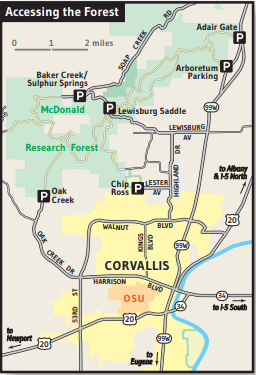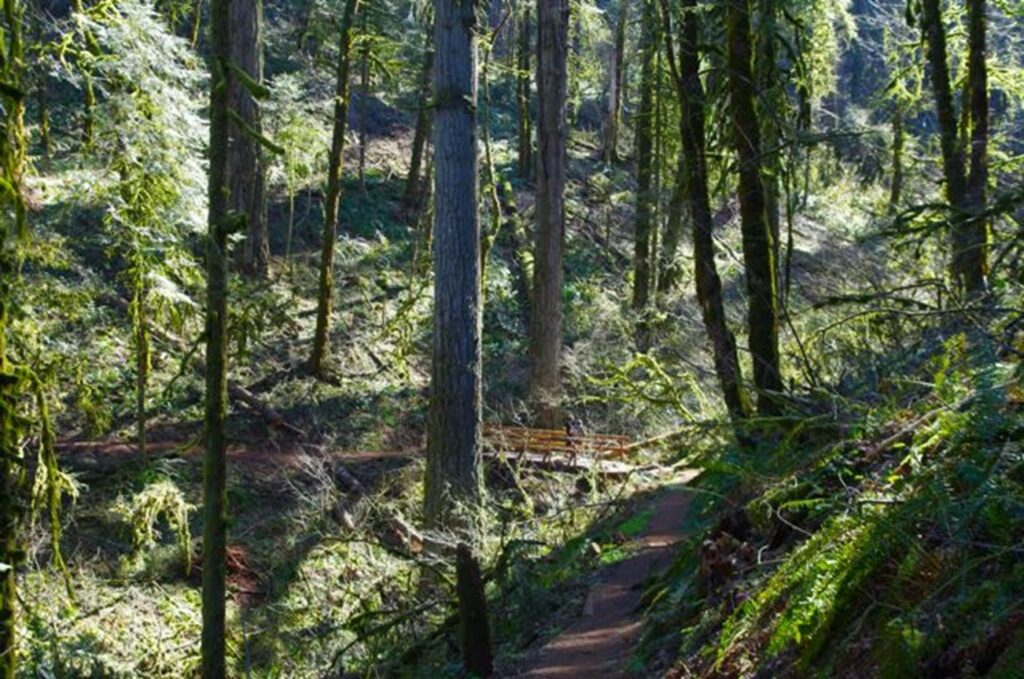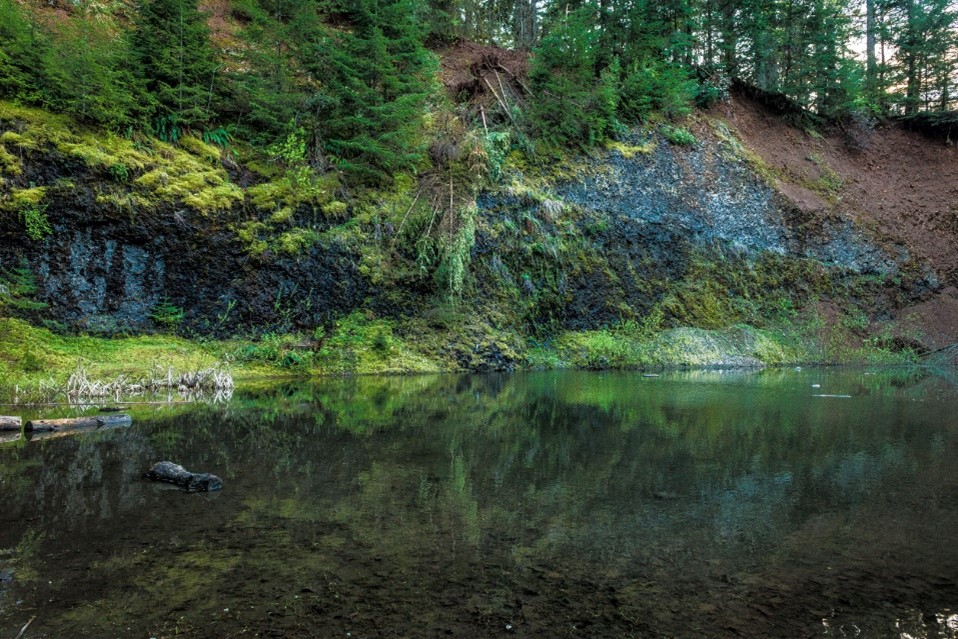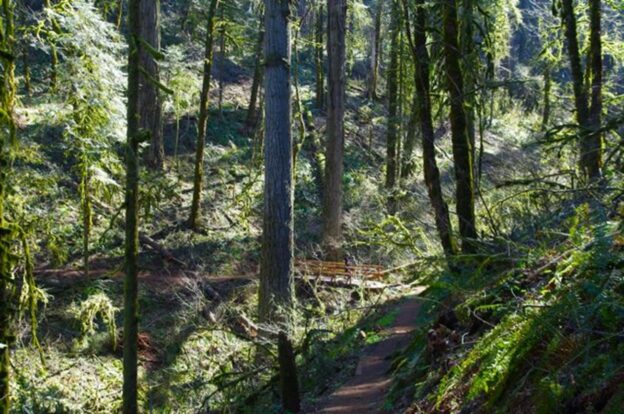I’ll be honest, I’m not very good at getting myself outside and into nature. Being a habitual couch-potato, I have the very embarrassing tendency to spend my whole day in front of a monitor, both for work and leisure. So, that being said, a few years back I found myself searching for an easy-to-access, local hiking trail that would let me comfortably explore the great outdoors without having to travel too far from home. Lucky for me, I found that Oregon State University’s McDonald State Forest fit this bill exactly, especially Lewisburg Saddle, my personal favorite trailhead to start on.
A Little Background
Managed by the Oregon State University College of Forestry, McDonald State Forest rests to the north and west of Corvallis, spanning approximately 11,250 acres and offering “26 miles of well-maintained trails and more than 100 miles of forest roads” (OSU College of Forestry), this vast, lush forest offers countless different options for both experienced hikers and more casual trail-walkers (such as myself). While the sprawling woodland may come across as any old public park, the forests “are actually living laboratories, managed by the OSU College of Forestry and dedicated to teaching, research, and demonstration” (OSU College of Forestry). This means that not only are trails open to public use, but the wood itself is one big educational facility.

Of the many different trailheads, Lewisburg Saddle is a personal favorite. Located to the north of Corvallis, west of highway 99W off Lewisburg Ave, and approximately halfway to the Sulphur Springs Trailhead on the same road, the Saddle is a fairly secluded-feeling location, home to two fairly lengthy forest roads and both the Old Growth and New Growth Trails. The trails are pet-friendly and open to foot traffic, mountain-bikers, and horses, and tend to be fairly crowded on the weekends. The advent of Covid-19 temporarily caused this number to drop considerably during mid to late 2020, but with increasing rate of vaccinations, the number of visitors seems to be gradually increasing.
Setting Out
When arriving at the trailhead, your first adventure will be finding a place to park. While the Saddle’s location may make it feel isolated, in the past the large influx of weekend hikers tended to make finding a place to park difficult, recently a new area was set aside a little further up the road to accommodate more parking, but you can never be too sure it won’t fill up too. That being said, usually there should be plenty of space, especially given the decreased number of visitors, but always keep in mind the very limited parking space if you decide to pay any of the McDonald Forest Trailheads a visit.
After parking, your first step should be to head over to the actual start of the trail. This is signified by the bright orange gate, information kiosk, and port-a-potty. From here you’ll see two roads before you: the road on the left heading downhill and the one on the right leading up. Both roads are completely open and free for public use, but it is important to keep in mind that they will not converge again for a very long time. For newcomers, I would wholeheartedly recommend the left path, as it directly connects to the aforementioned New Growth and Old Growth Trails.

This pair of trails makes up the “Lewisburg Saddle Old Growth Hike”, an immediately accessible set of trails that takes hikers off the main road and down into a small valley. The Old Growth Hike loop runs you about two miles, beginning with the New Growth Trail, transitioning into the Old Growth Trail, then finally remerging further down the forest road.
The path itself descends into a smaller valley through a formerly clear-cut region, now sporting new, young Douglas-firs. The very deliberate spacing of these young trees is itself a part of a study hoping “to monitor optimal growth and wood quality based upon various planting configurations” (Bobcat). After crossing a small creek and a downed tree, you will reach a split in the path. The right path ascends back to the main forest road, while the left path marks the beginning of the Old Growth Trail.
The Final Stretch
The Old Growth Trail takes hikers down a bit further, winding around the edges of the small valley. The path will take you over three additional footbridges along its course, before concluding at a set of ascending switchbacks that return you to the forest road. From here you can continue left along the road, or turn right and head back to the trailhead, completing the loop. The road back is entirely uphill and will eventually walk you past an old, abandoned quarry. I always find myself stopping here to look into the smaller lake that formed in the bottom. The water is home to Rough-skinned newts, and it can be enjoyable to watch the small amphibians swim around while you take a break on your hike back.
The “Lewisburg Saddle Old Growth Hike” starts at a split from the lower forest road approximately 200 yards or so from where the forest roads fork. On your left you will see a brown sign signaling the start of the New Growth Trail, where it begins its gradual descent.

Don’t Forget!
An important note to keep in mind is how steep all the entrances/exits to the New Growth and Old Growth Trails are. While the first entrance to the New Growth Trail is a gradual incline, the sustained nature of the slope can make this an incredibly tiring ascent if you decide to walk the hike in reverse. Conversely, while the later entrances/exits to the paths are substantially steeper, their shorter, switchback nature makes them quite a bit less taxing in the long run. Finally, as with most natural areas throughout Oregon, you should always keep a lookout for poison-oak, as it can occasionally be found on the side of paths.
Get Out There!
Hopefully, this has given you a bit of insight into one of the many different trailheads around McDonald State Forest, and a personal favorite of my own. If you ever decide to go out and explore McDonald Forest (both for the first time or for another), then I invite you to go out and check out the “Lewisburg Saddle Old Growth Trail Hike”. While it isn’t the most difficult of trails, it does make for a nice afternoon hike through Oregon’s lush greenery and an especially good introduction for hiking hopefuls!
References
Bobcat. “Lewisburg Saddle Old Growth Hike.” OregonHikers.org, 12 May 2021, www.oregonhikers.org/w/index.php?title=Lewisburg_Saddle_Old_Growth_Hike&action=history.
Interdisciplinary Planning Team. McDonald-Dunn Forest Plan. Oregon State University College of Forestry, 2005, cf.forestry.oregonstate.edu/sites/default/files/mcdunn_plan.pdf.
OSU College of Forestry. “McDonald Forest Visitor Guide and Map.” Oregon State University College of Forestry, cf.forestry.oregonstate.edu/sites/default/files/_ResearchForestLAYOUT30May18.pdf. Accessed 18 May 2021.
Image Credits
Figure 1.
OSU College of Forestry. “McDonald Forest Visitor Guide and Map.” Oregon State University College of Forestry, cf.forestry.oregonstate.edu/sites/default/files/_ResearchForestLAYOUT30May18.pdf. Accessed 18 May 2021.
Figure 2.
Bobcat. LewisburgOldGrowth6.jpg. 03:11, 18 March 2015. “Lewisburg Saddle Old Growth Hike,” by Bobcat. OregonHikers.org, 12 May 2021, www.oregonhikers.org/field_guide/Lewisburg_Saddle_Old_Growth_Hike.
Figure 3.
Whitney, Melissa. LEWISBURG SADDLE HIKE. 2015, melissawhitneyphotography.com/2015/03/31/lewisburg-saddle-hike/.


